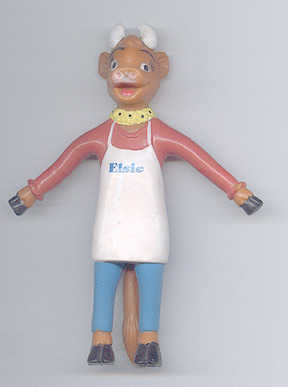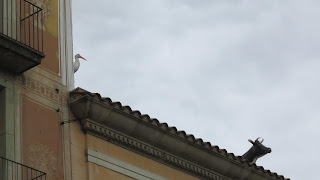Sunday we left Southern France and took a pleasant train ride down the
coast into Northern Spain. This is part of the Costa Brava region of the Mediterranean; selected by National Geographic Traveler as a "Best Trip of 2012."
The train was high-speed electric - so
quiet and enjoyable. We hope to one day be able to ride between Duluth and
Minneapolis that way! We arrived in Figueres, Spain and ate lunch outside at a restaurant looking over the town square - lovely and sunny. Only one slight translation mix-up, the fish described for Anne's dish was actually octopus ...hmmmm, (I made it through half of it).
The next day we went out
to breakfast for coffee and a lovely Brioche dipped in chocolate before our visit the Dalí Theatre - Museum, the largest surrealistic object in the world. Dalí is of course known for his surrealistic work. The museum
occupies the building of the former Municipal Theatre, a 19th century
construction which was destroyed at the end of the Spanish Civil War. On
its ruins, Dalí decided to create his museum as a gift to the town that he loved. Since it was designed by him it is actually a work of art in and of itself. There are many, many representations of bread in and on the building as well as other themes repeated as only a compulsive, surrealistic artist can do.
It seems the the entire town has embraced Dali and the surrealist approach to decorating. One building has cow statutes on its facade and another has a cow and a goose peering over the eave.
In the afternoon we went to the Toy Museum in Figueres, which was very fun and much easier to understand. This place takes you on a great trip through history of play. They display toy cars, robots, dolls, boardgames, puppets and everything related to the way people
have been playing in the past centuries. There was even a little hop scotch court by the doorway where we could resurrect our childhood skills.
We took a short train ride to our next stop, the city of Gerona. Gerona is an ancient walled city where large portion of the Roman wall still exists and much of it is accessible by foot. The narrow streets climb steeply from the river Onyar and up to the wall. We stayed two nights in Gerona which allowed us time for a short bus to the Mediterranean fishing port of Saint Feliu De Guixols. We were lucky to have a nice sunny day for a walk and a little snooze on the coast. We really loved Gerona and had a great time exploring its' nooks and crannies.
Gerona is much larger than Figueras, but then we hit the huge city of Barcelona to conclude our Southern holiday. Thanks to Susie we know this is pronounced "Barthelona" and ever since we have been talking as if we have a lisp. There are a million things to see and do there, however our visit actually centered around the interesting modernism architecture with a bit of flamenco dance thrown in.
Modernisme,
Catalan
for "modernism" was a cultural movement associated with the search for
Catalan national identity. It is often understood as an equivalent to a
number of art movements, such as Art Nouveau, Jugendstil,
Secessionism, and Liberty style, and was active from roughly 1888 to
1911.
We took a walk down the Illa de la Discòrdia ( block of Discord), which is a block on Passeig de Gràcia in the Eixample District of Barcelona. The block is noted for having buildings by four of Barcelona's most important Modernista architects, Lluís Domènech i Montaner, Antoni Gaudí, Josep Puig i Cadafalch and Enric Sagnier,
in close proximity. As the four architects' styles were very different,
the buildings clash with each other and the neighboring buildings. They
were all built in the early years of the 20th century. We were able to enjoy it without feeling too much discord.
One of the better known architects of the period is Antoni Gaudi who's work is visible throughout the city. We spent quite a bit of time at Park Guell looking at his home ( now a museum) and the grounds where he had installed many of his pieces. It was crowded with visitors and a long walk up a very steep hill, but we enjoyed the chance to see his buildings and incredible mosaics.
After seeing the work of Dalí and Gaudi, we have decided this is the vacation of bizarre and unusual artists.
One interesting feature of Barcelona is the number of motor scooters on the streets. It was not unusual to see 30 of 40 motor bikes at a stoplight at any given time. Clearly the law requires the wearing of helmets but not noise dampening mufflers. It is a very big and busy city.
One evening we went to a traditional Flamenco dance, which Linda captured on video. It was a fascinating evening which we thoroughly enjoyed. (More of her video is available on YouTube if you have a lot of time.)
Flamenco is an art that includes to variants: music and dance. Singing, guitar and percussion (clapping) all play an important role. Each song is interpreted with a different kind of dance with it's own rhythm and harmony. The dances can be very serious and express profound feelings that are often tragic; dealing with love, disappointment or sadness. Others are livelier and deal with happy feelings of love and various scenarios relating to flamenco, which at times can even be comical.
When our time in the South ran out, Carol took the train back to Gerona to catch a flight back to the USA and Anne and Linda flew up to Holland for a few days stay in Amsterdam. See part three of Spring break. And don't forget to check the photo albums.



No comments:
Post a Comment